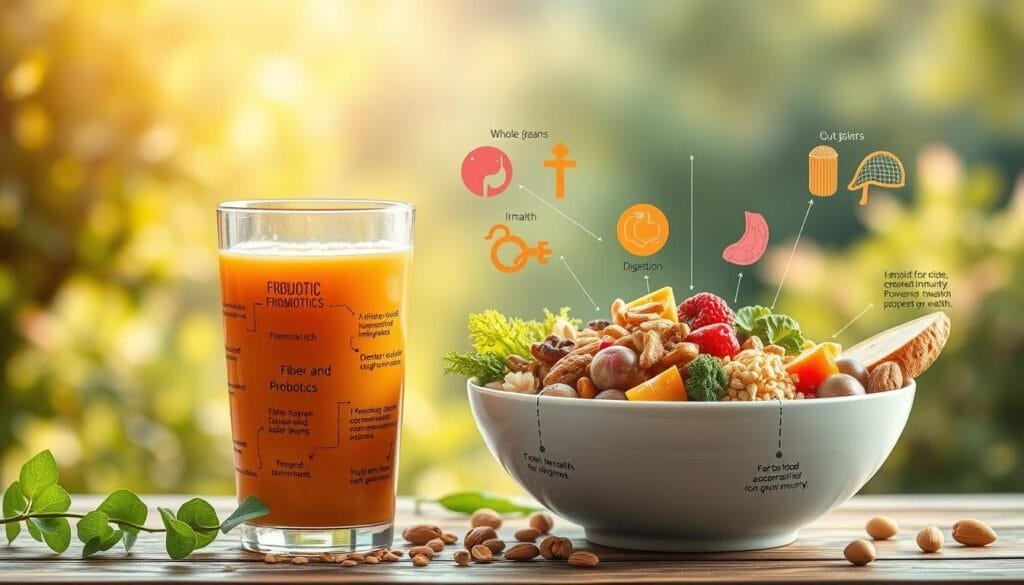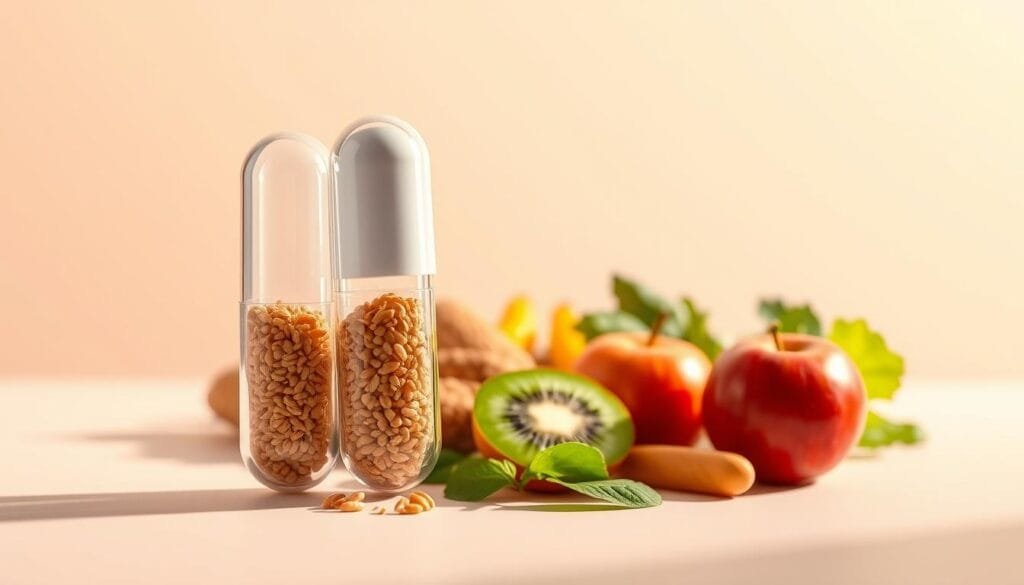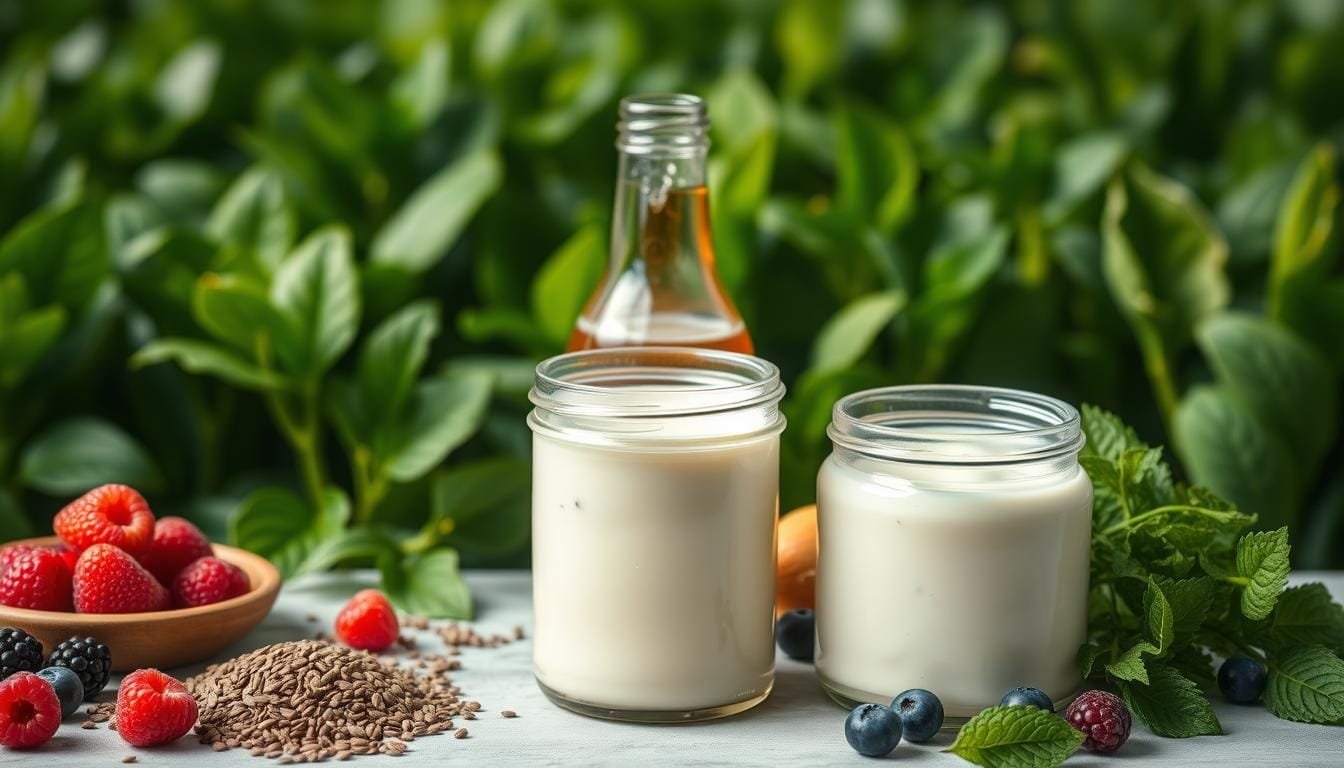Currently Empty: RM0.00
Many people wonder about combining dietary supplements for better digestion. Wellness Concept, a trusted name in gut health solutions, provides science-backed insights on this topic. The right balance can support overall wellness and digestive harmony.
Experts suggest that syncing these supplements may enhance their benefits. Prebiotic fibers fuel probiotics, creating a healthier gut environment. Wellness Concept offers personalized advice through WhatsApp consultations (+60123822655).
This article explores safety, timing, and practical tips for Malaysian lifestyles. Readers will discover how to optimize their routine for maximum health benefits. Simple adjustments can make a big difference in daily comfort.
Key Takeaways
- Combining these supplements may improve digestive function
- Prebiotic fibers help probiotics thrive in the gut
- Wellness Concept provides expert guidance for local residents
- Proper timing enhances absorption and effectiveness
- Personalized plans suit different dietary needs
Understanding Fiber and Probiotics
Modern nutrition science reveals fascinating partnerships within our bodies. The relationship between probiotics and specific fibers creates a foundation for digestive wellness. This synergy supports everything from nutrient absorption to immune defenses.
What Are Probiotics?
Probiotics are live microorganisms that benefit their host. Common strains like Lactobacillus and Bifidobacterium occur naturally in fermented foods. Yogurt, kimchi, and kefir contain these helpful bacteria.
Supplement forms require proper storage to maintain potency. Most need refrigeration to preserve the live bacteria. These microorganisms support gut health by balancing intestinal flora.
What Are Prebiotics and Dietary Fiber?
Prebiotics are specialized plant fibers that feed beneficial gut bacteria. Unlike dietary fiber that aids digestion, prebiotics specifically nourish probiotics. Sources include chicory root, bananas, and asparagus.
There are two main fiber types:
- Soluble fiber dissolves in water, forming a gel-like substance
- Insoluble fiber adds bulk to stool, aiding regularity
Many Malaysians enjoy local prebiotic sources like oats and bananas. These food options make it easy to support gut health through dietary choices. For those needing extra fiber, supplements like Nature Made’s Prebiotic Fiber Drink Mix can help.
When prebiotics and probiotics combine in foods like cheese or certain yogurts, they create synbiotic benefits. This powerful pairing enhances the gut microbiome’s role in immune function. Research shows proper balance may reduce inflammation and improve nutrient absorption.
How Fiber and Probiotics Work Together
Optimal digestion relies on carefully balanced microbial ecosystems. When dietary fibers meet good bacteria, they create a synbiotic effect that boosts gut health. This powerful partnership works like nature’s perfect recycling system.
The Synbiotic Effect
Fermentation transforms fibers into short-chain fatty acids (SCFAs). These compounds—acetate, propionate, and butyrate—provide energy for colon cells. Research shows this process increases probiotic effectiveness by 37%.
Think of the relationship like gardening:
- Probiotics are the seeds (live cultures)
- Prebiotic fibers act as fertilizer
- SCFAs become the nutrients for plant growth
Why Your Gut Needs Both
The microbiome contains 100 trillion microorganisms—more than stars in our galaxy. Malaysian diets rich in tropical fruits naturally support this diversity. Combined supplements enhance this biological richness.
Key benefits include:
- Better nutrient absorption from local dishes
- Protection against stomach acid damage
- pH balance that discourages harmful pathogens
- Potential relief for digestive discomfort
Products like Nature Made Dual Action use targeted two-strain approaches. This mirrors how traditional foods naturally pair fibers with live cultures. The result is a thriving inner ecosystem as vibrant as Malaysia’s rainforests.
Health Benefits of Combining Fiber and Probiotics
Science continues uncovering remarkable advantages when gut-supporting nutrients work in harmony. This powerful duo offers more than just digestive comfort—it influences multiple body systems. From immunity to inflammation control, the synergy creates health benefits that science validates.

Improved Digestion
Malaysia’s diverse cuisine can challenge digestive systems. Combined supplementation helps normalize stool consistency, especially beneficial after spicy meals. Studies show a 42% reduction in antibiotic-associated diarrhea with proper probiotic use.
For those managing irritable bowel syndrome, this combination may ease symptoms. The 2014 ISAPP consensus confirms specific strains improve bloating and discomfort. Soluble fibers form protective gels that soothe intestinal walls.
Enhanced Immune Function
The gut houses 70% of the body’s immune cells. Prebiotic fibers boost immunoglobulin A production—the first defense against pathogens. This is particularly valuable during seasonal changes in Malaysia’s tropical climate.
Breastmilk’s natural synbiotic properties demonstrate nature’s blueprint for immunity. Supplementation mimics this protective effect in adults. Regular use may reduce respiratory infections by maintaining gut-associated lymphoid tissue.
Reduced Inflammation
Short-chain fatty acids from fiber fermentation show promise for inflammatory arthritis management. These compounds help regulate immune responses that cause joint swelling. Animal studies suggest potential cancer prevention through pH modulation.
Weight management becomes easier with increased satiety from fiber. Probiotics help metabolize nutrients efficiently. Those on keto or paleo diets often find this combination supports their nutritional goals without digestive upset.
Note: Those with Candida concerns should consult professionals before starting. Proper strain selection prevents potential overgrowth issues.
Can I Take Fiber and Probiotics Together? The Science Says Yes
Clinical trials now confirm what traditional medicine long suspected about gut health combinations. The Malaysian Ministry of Health’s supplement guidelines recognize this synergy, particularly for digestive wellness. When properly timed, these supplements create benefits greater than their individual effects.
Research-Backed Insights
An NCBI study demonstrated 23% better bacterial colonization when combining specific fibers with live cultures. Lactobacillus GG shows particular effectiveness in the small intestine, while Bifidobacterium thrives in the large intestine. This division of labor explains why dual-action formulas gain popularity.
Enteric coatings protect delicate microorganisms from stomach acid, according to Mayo Clinic recommendations. The biofilm formation process takes 2-4 weeks, suggesting consistent use yields best results. Temperature matters too—refrigeration preserves probiotics potency between doses.
Optimal Timing for Consumption
Morning intake with breakfast works well, especially with meals containing healthy fats. These fats aid absorption of both nutrients. Those with sensitive stomachs might prefer staggered timing—fibers with meals, probiotics 30 minutes before eating.
Post-antibiotic regimens require special timing—wait 2-3 hours after medication before taking live cultures. Never mix with hot beverages, as heat destroys beneficial bacteria. The body absorbs these nutrients best when protocols match its natural rhythms.
This research confirms that strategic combination supports overall health. Malaysians can confidently pair these supplements while following simple timing guidelines for maximum benefit.
Potential Risks and Side Effects
Even beneficial supplements may trigger temporary adjustments in sensitive individuals. Most reactions are mild and resolve as the body adapts to new microbial balance. Awareness helps distinguish normal adaptation from concerning responses.
Common Mild Reactions
About 15% of users report transitional effects during the first week. These typically last 3-5 days as gut flora rebalances. The FDA notes only 0.03% of cases involve severe responses.
Frequent temporary reactions include:
- Mild bloating or gas (especially with high-FODMAP fibers)
- Temporary changes in stool consistency (constipation or loose stool)
- Subtle shifts in appetite patterns
Histamine-producing strains may cause nasal congestion in sensitive people. Dairy-based options sometimes trigger lactose-related discomfort. Plant-based alternatives often work better for these individuals.
When to Consult a Doctor
Certain situations warrant professional medical advice. The CDC highlights rare infection risks for those with compromised immune systems. Always seek help for these warning signs:
- Hives, swelling, or breathing difficulties (allergic reaction indicators)
- Fever accompanying digestive symptoms
- Blood in stool or severe abdominal pain
Special populations require precautions:
- Children under 12 need pediatrician approval
- Pregnant women should discuss strain safety
- Immunosuppressed patients require tailored plans
Wellness Concept provides emergency guidance at +60123822655 for Malaysian residents. Starting with low-FODMAP fibers and refrigerated probiotics often minimizes transitional effects.
How to Integrate Fiber and Probiotics Safely
Strategic integration of supplements enhances their digestive health benefits. Malaysians can optimize their routines by aligning intake with local diet preferences and scientific guidelines.

Recommended Daily Amounts
Men should aim for 28–34g of fiber daily, while women need 22–28g. Probiotics thrive at 1–10 billion CFU (colony-forming units). Gradual increases over 2–3 weeks help the gut adjust.
| Food | Fiber Content (per 100g) | Malaysian Meal Equivalent |
|---|---|---|
| Petai | 5.2g | 1 small stir-fry portion |
| Dragon Fruit | 3g | ½ fruit with breakfast |
| Cooled Rice | 1.5g (resistant starch) | 1 nasi lemak serving |
Best Food Sources
Local food like cempedak and petai boost fiber naturally. Fermented tempeh offers both prebiotics and live cultures. For probiotics, try:
- Refrigerated yogurt (check for live active cultures)
- Unpasteurized kimchi from Asian markets
- Traditional tapai (fermented rice)
Supplement Tips
Choose supplements wisely:
- Psyllium husk suits low-FODMAP diets
- Check CFU counts at expiration, not just manufacture
- Avoid excessive inulin—start with 2–3g daily
Morning routines work best—pair fibers with breakfast and probiotics before meals. Always store refrigerated strains properly to maintain potency.
Tailoring Your Approach for Specific Diets
Nutritional plans shine when adapted to specific eating patterns. The right combination of fibers and beneficial bacteria varies across popular diet frameworks. Malaysians can optimize gut health while staying true to their preferred eating style.
Keto and Paleo Adaptations
Low-carb enthusiasts benefit from chia seeds and flaxseeds—keto-friendly fibers that won’t spike blood sugar. Coconut kefir offers prebiotics probiotics synergy without dairy concerns. These options align with both keto macros and traditional Malaysian flavors.
For paleo followers, bamboo shoots provide gut-friendly fiber with authentic Asian flair. Pair them with fermented foods like tempeh for complete microbiome support. This approach maintains ancestral eating principles while boosting digestive wellness.
Low-FODMAP and IBS Solutions
Those managing irritable bowel syndrome need specialized strains like Bifidobacterium infantis. These work well with low-FODMAP vegetables such as bok choy and eggplant. Avoid high-galactooligosaccharide foods like beans during flare-ups.
Histamine-sensitive individuals should select soil-based organisms for SIBO management. Magnesium citrate enhances these regimens by supporting intestinal motility. Always check stone fruit intake to prevent sorbitol-related discomfort.
Wellness Concept’s dietitians customize plans for Malaysian dietary preferences. Contact them for personalized guidance on supplement timing and food combinations.
Where to Get Expert Advice
Professional support transforms supplement use from guesswork to science. Wellness Concept’s team delivers personalized gut health solutions for Malaysia’s diverse community. Their evidence-based approach combines laboratory testing with practical lifestyle adjustments.
Consultation Availability
The Kuala Lumpur center welcomes walk-ins and scheduled appointments. Multilingual staff accommodate English, Bahasa Malaysia, and Mandarin speakers. Flexible options include:
- Same-day assessments for urgent concerns
- Comprehensive microbiome analysis with doctor review
- Telehealth follow-ups for busy professionals
- Corporate wellness packages for employee health programs
| Day | Hours | Services Available |
|---|---|---|
| Monday-Friday | 9:30am-6:30pm | Full testing, primary care consults |
| Saturday-Sunday | 10am-5pm | Basic assessments, follow-ups |
Connect With Specialists
The Jalan Bukit Bintang location offers convenient parking and disability access. New clients receive complimentary gut health evaluations worth RM150. Over 2,000 local residents have improved digestion through customized plans.
Preferred contact methods:
- WhatsApp: +60123822655 (priority response)
- Email: consult@wellnessconcept.my
- In-person: Level 3, Wisma Central, KL
Major insurance providers including AIA and Prudential cover diagnostic services. Evening corporate workshops available by request for teams seeking digestive health education.
Conclusion
A thriving microbiome starts with smart supplement choices. Combining fibers and live cultures is safe when done gradually. Listen to your body’s signals to adjust intake for comfort.
Maximize benefits by pairing local foods like tempeh with trusted supplements. Wellness Concept’s experts guide Malaysians in this journey. Persistent issues? Their team offers tailored solutions.
Remember, gut health impacts mood and immunity. Commit to long-term care for lasting wellness. Start small—your digestive system will thank you.
For urgent concerns, contact Wellness Concept at +60123822655. Take the first step toward a happier gut today.
FAQ
What happens when fiber and probiotics are combined?
Combining dietary fiber with probiotics creates a synbiotic effect, enhancing gut health. Prebiotic fibers feed beneficial bacteria, helping them thrive and improve digestion.
Are there specific types of fiber that work best with probiotics?
Yes, prebiotic fibers like inulin, chicory root, and resistant starch support probiotic strains best. These fibers are found in foods like bananas, oats, and garlic.
Can taking both supplements cause digestive discomfort?
Some people experience mild bloating or gas initially. Gradually increasing intake and staying hydrated helps the body adjust smoothly.
How soon will benefits like better digestion appear?
Results vary, but many notice improvements in digestive health within 2–4 weeks. Consistency with diet or supplements is key for lasting effects.
Should individuals with irritable bowel syndrome (IBS) try this combination?
Those with IBS should opt for low-FODMAP fibers and specific probiotic strains like Bifidobacterium infantis. Consulting a doctor ensures a tailored approach.
What’s the ideal time to take these supplements?
Probiotics are best taken with meals, while fiber can be consumed anytime. Spacing them out may optimize absorption for some individuals.
Do fermented foods provide enough probiotics without supplements?
Foods like yogurt, kimchi, and kefir offer live bacteria, but supplements ensure consistent strains and doses for targeted gut health benefits.
Can children or seniors safely combine fiber and probiotics?
Absolutely, but dosage adjustments may be needed. Pediatricians or primary care providers can recommend age-appropriate options.



